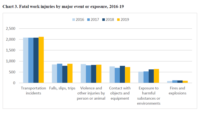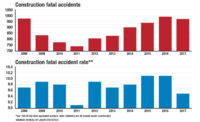Fatal accidents on construction jobsites rose 5% in 2016, and the industry's workplace death rate stayed flat from the previous year's level, the federal Bureau of Labor Statistics says.
The latest annual BLS report on fatal occupational injuries and incidents, released on Dec. 19, shows that private-sector construction deaths increased to 991 from 937 in 2015.
The 2016 total was the largest number of fatalities in recent years and exceeded the 2008 level of 975.
Construction's fatality rate in 2016 was 10.1 per 100,000 full-time-equivalent workers, the same as in 2015. The rate stayed flat because the construction workforce has been expanding. Construction employment totaled 6,783,000 in December 2016, up 155,000, or 2%, from the year-earlier level.
Specialty-trade contractors recorded 631 fatalities, the buildings sector had 182, and heavy-civil engineering construction had 159, according to BLS.
Chris Cain, North America's Building Trade Unions director of safety and health, said in an email, "While I am encouraged that the rate is flat, the numbers are still too high."
One factor behind the rise in fatal accidents is the continued increase in the overall construction workforce, Cain noted. But she added, "Even so, we can't be comforted by the numbers, as any loss of life on a construction site is unacceptable."
Brian Turmail, a spokesman for the Associated General Contractors of America, said via email, "Our concern for some time now has been that, as the industry continues to expand in an environment where there are so few qualified workers available, many firms are having to hire individuals with less experience than [the firms] would prefer."
Turmail added, "These new and relatively inexperienced workers are more likely to put themselves and others in harm's way, especially within the first 90 days or so on a jobsite."
Digging into the details of the BLS report, Cain pointed out that falls are the "No. 1 killer in construction," with 388 fatalities in 2016—36% of the industry's total jobsite deaths. Moreover, the number of fall-related deaths is up from 367 in 2015.
Cain also noted that Hispanic construction workers' fatalities remained nearly level—286 in 2016 and 285 the year before. "If that indicates a decrease in the rate of Hispanic construction-worker fatalities," she said, “that will be good news."
Moreover, she said, "I am troubled by the reported increase in overdose fatalities." Although the BLS data don't provide a breakdown of overdose deaths in construction, Cain added, "We are hearing more and more about how large the opioid problem is in our industry, and now [it's] time to do more about it."
Within the building trades, Cain said, "We are working to find new solutions to reduce the workplace injuries that cause pain, the over-prescription [or] misuse of pain medication and the lack of treatment and recovery support for when construction workers become addicted to opioids."
Turmail noted that AGC has disseminated information to member companies on how to promote safety among new hires and commissioned a Virginia Tech study, released in April, of construction fatality reports over three years. He added, "Nobody should ever have to be at risk because of their job."
BLS also reported that, overall, U.S. workplace fatalities were up in 2016, climbing 7%, to 5,190, the highest since 2008. The national fatal injury rate edged up to 3.6 in 2016 from 3.4 the year before.
Loren Sweatt, assistant labor secretary for occupational safety and health, said in a statement, "Today's occupational fatality data show a tragic trend, with the third-consecutive increase in worker fatalities in 2016—the highest since 2008."
Sweatt, a former AGC official and congressional aide, said, "The Occupational Safety and Health Administration is committed to finding new and innovative ways of working with employers and employees to improve workplace safety and health. OSHA will work to address these trends through enforcement, compliance assistance, education and training, and outreach."



